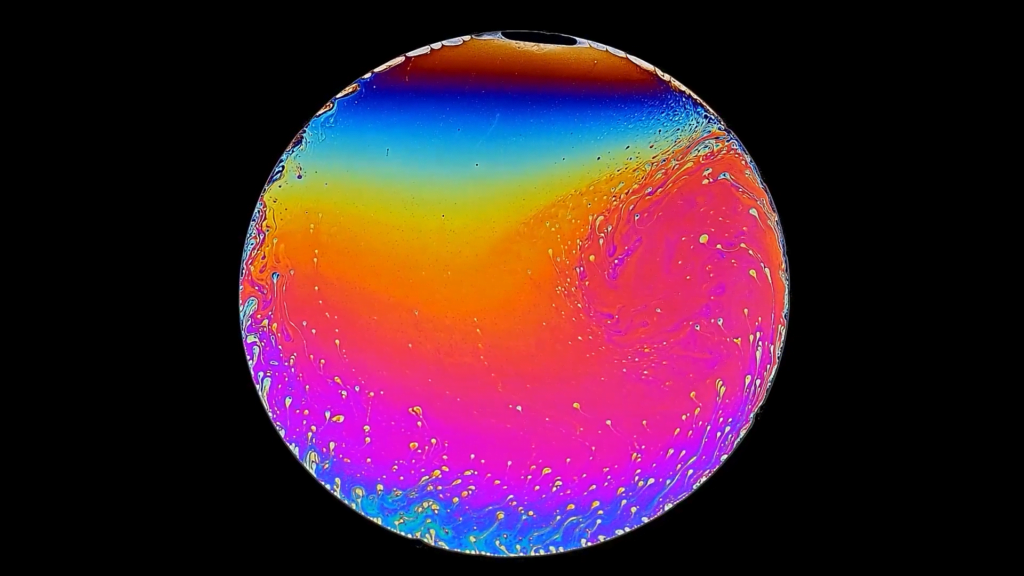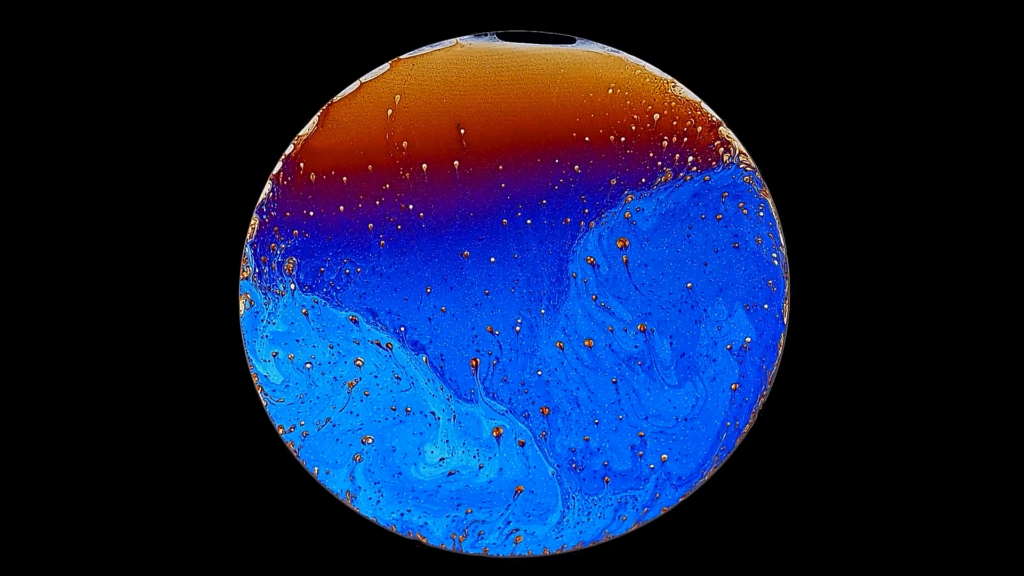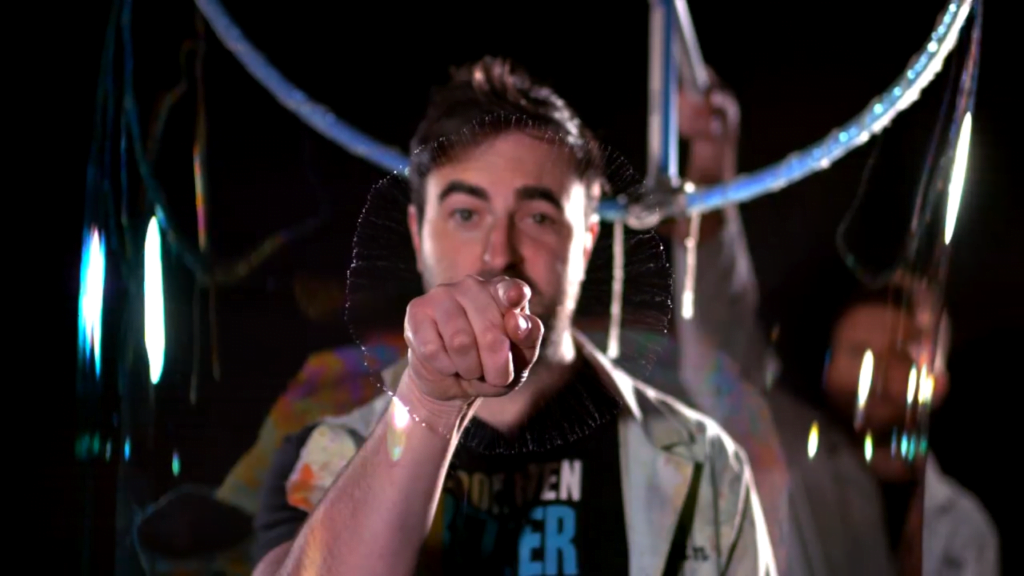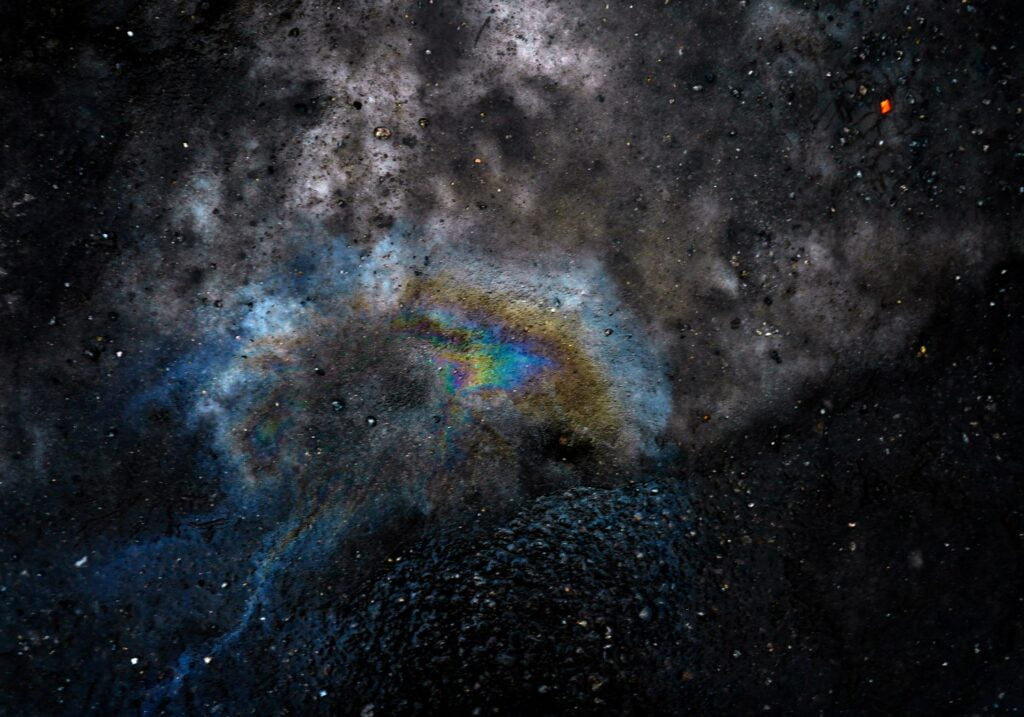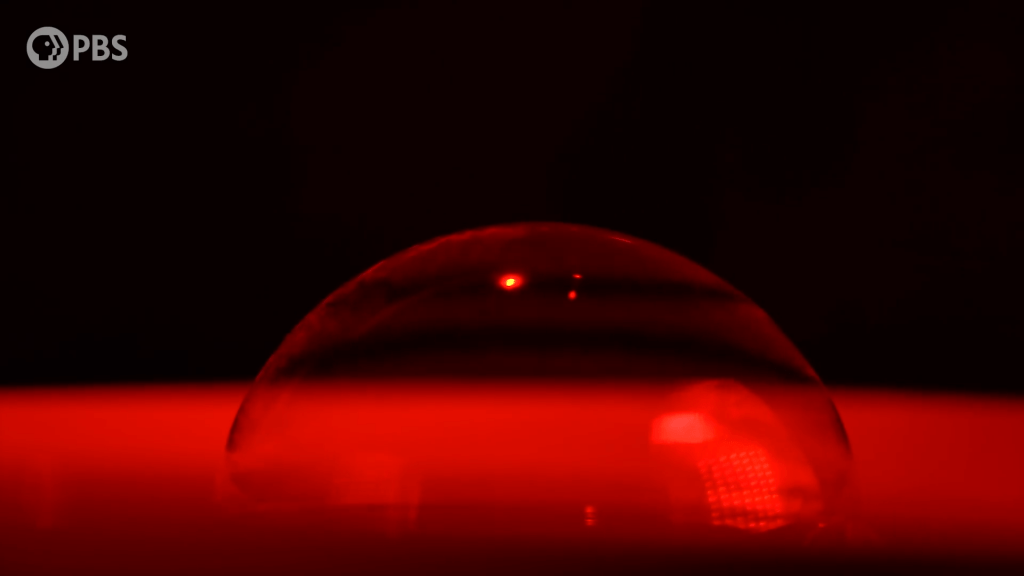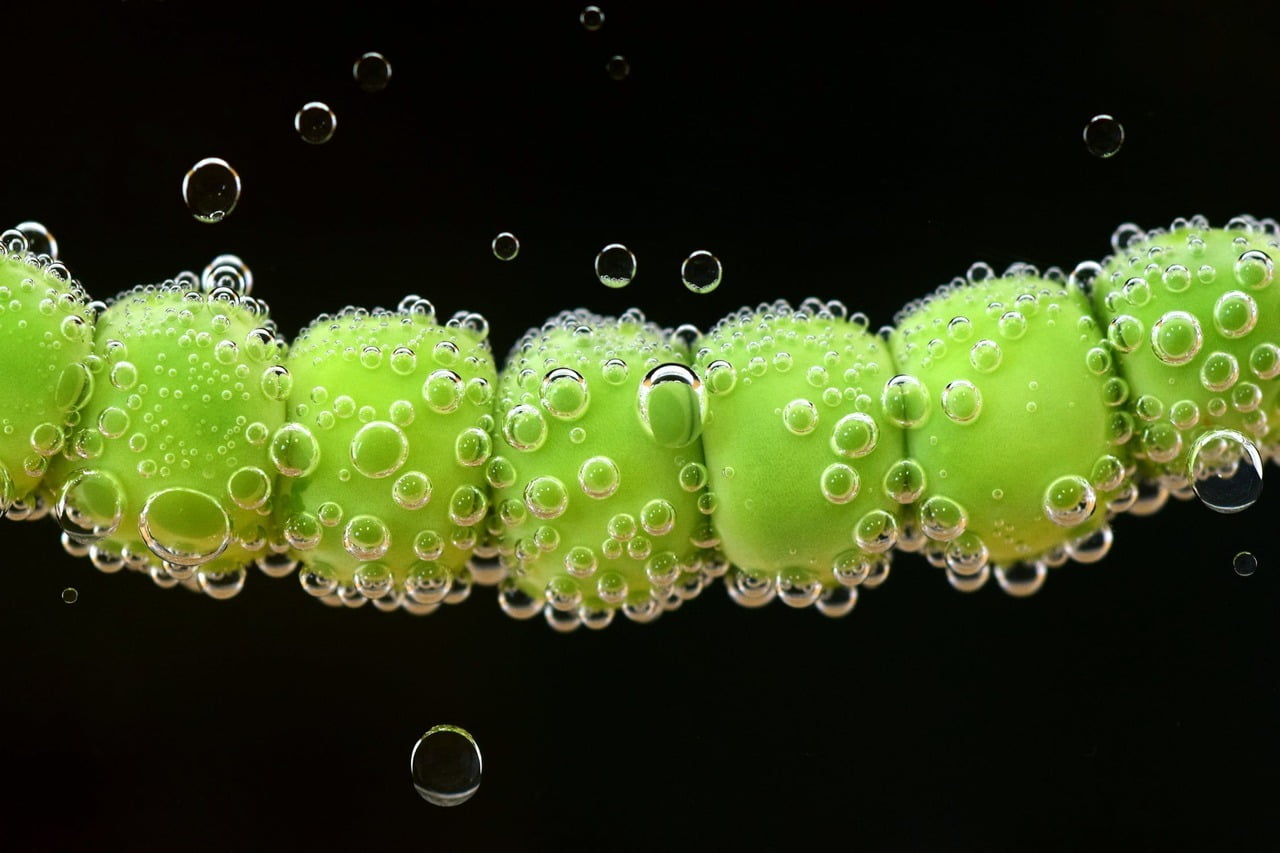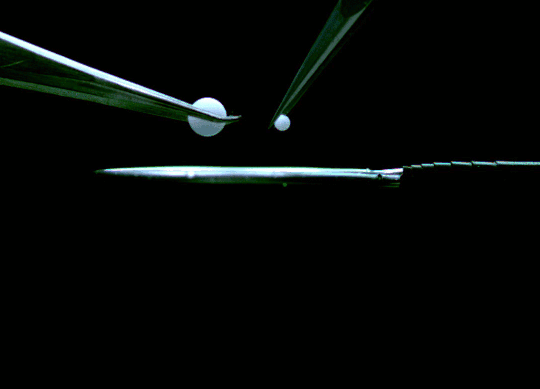Bright colors mark this slowly draining soap film. The film sits slightly off-horizontal, so flow shifts over time from the top of the frame to the bottom. The fluid is also evaporating. All the faster shifts are caused by ambient air currents from the room. The colors of the film are directly related to the local thickness; as the film thins and evaporates, the bright colors shift to darker ones. Eventually, that black region at the top will expand and the film will break up. (Video credit: B. Sandnes/Complex Flow Lab)
Tag: thin film

Box Closing Physics
My fellow board game aficionados (and anyone else who regularly opens and closes lidded boxes) have probably noticed the way a lid drops slowly onto its box once aligned. The weight of the lid pressurizes air inside the box, driving a flow through the narrow gap between the walls of the box and the lid. Researchers found that the time it takes for a box to slide closed is closely related to the size and shape of the gap between the walls. Despite gaps of less than 1 millimeter, air moving out of the box typically flows at about 1 meter per second!
With their mathematical model of the flow from a closing box, the group was also able to determine the optimal shape for a fast-closing box, something that may be of interest to manufacturers as well as fans of board games. (Image credit: N. Sharp; research credit: J. de Ruiter et al.; via APS Physics)

Within the Bubble’s Pop
To our eyes, a soap bubble appears to pop instantly, but when observed in high-speed video, the process is far more complex. In this video, the Slow Mo Guys pop human-sized bubbles, giving us an opportunity to appreciate the rupture process at speeds up to 50,000 frames per second.
Once the rupture starts, the hole spreads very symmetrically. But as the hole grows, the remaining soap film starts distorting. As Gav and Dan observe, the far side of the bubble actually wrinkles up before the rupture front arrives and tears the remaining fluid into droplets! (Image and video credit: The Slow Mo Guys)

“Oil Paintings”
To capture his images of auroras, nebulas, and comets, photographer Juha Tanhua points his camera lens downward, not upward. Despite their astrophysical appearance, Tanhua’s “oil paintings” are actually parking lot oil spills. The stars are roughened bits of asphalt, and the colors come from thin film interference in a layer of oil (similar to the way colors appear in soap bubbles). It’s amazing how much beauty he captures in examples of urban pollution. (Image credit: J. Tanhua; via Colossal)

The Colors of a Thin Film
Soap bubbles and other thin films are colorful thanks to wave interference across their tiny thickness, but you may have noticed that only some colors appear. Others, like red, seem to be missing. In this video, Dianna digs into the details of wave interference and color theory to explain why we don’t see pure colors in a bubble.
As she points out near the end of the video, the way to make a red bubble is to shine purely red light on the bubble, but even then, you’ll see stripes on it related to the light’s wavelength. Scientists actually use this property to measure the thickness of tiny air gaps between a droplet and a surface. (Image and video credit: Physics Girl)

Using Bubbles to Keep Clean
Keeping produce clean of foodborne pathogens is a serious issue, and delicate fruits and vegetables like tomatoes cannot withstand intense procedures like cavitation-based cleaning. But a new study suggests that simple air bubbles may have the power to keep our produce free of germs.
In particular, researchers studied air bubbles injected into water as they bounced and slid along an inclined solid surface. They found that as a bubble approaches a tilted surface, it squeezes a thin film of liquid between itself and the surface. That flow creates a shear stress that pushes contaminants like E. coli away from the point of impact. When the bubble bounces away, fluid gets sucked back into the void left behind, creating more shear stress. In their experiments and simulations, the team measured shear stresses greater than 300 Pa, more than double what’s needed to remove foodborne bacteria like Listeria. (Image credit: Pixabay; research credit: E. Esmaili et al.)

Soap Film Evolution
The beautiful colors of a soap film reflect its variations in thickness. As a film drains and evaporates, it turns to shades of gray and black as it gets thinner. More than fifty years ago, one scientist proposed a free-energy-based explanation for how such ultrathin films might evolve. But it’s taken another half a century for experimental techniques to reach a point where the thickness of these ultrathin films could be measured well enough to test that theory. The new mechanism, known as spinodal stratification, has been observed in both vertical films (top) and foam (bottom) but has so far not been observed in any horizontal configuration, suggesting that buoyant effects are likely important, too. (Image and research credit: S. Yilixiati et al.; submitted by James S.)

The Challenges of Blowing Bubbles
Although every child has experience blowing soap bubbles with a wand, only in recent years have scientists dedicated study to this problem. It turns out to be a remarkably complex one, with subtleties that can depend on the size of the wand relative to the jet a bubble-blower makes as well as the speed at which the air impacts the film. A recent study found that, at low or
moderate speeds, the film takes on a stable, curved shape (top image), but once you increase to a critical speed, the film will overinflate and burst. The key to forming a bubble, the authors suggest, is hitting that critical speed only briefly; if you slow down before the film ruptures, then the bubble has a chance to disconnect and form a sphere without breaking.The work also suggests there are two reliable methods for bubble making in this way. One is to impulsively move the wand through the background fluid, as shown in the lower animation. The other is the one familiar to children: blow a jet just fast enough to overinflate the film, then let up so the bubble forms without breaking. (Image and research credit: L. Ganedi et al.; via Ars Technica; submitted by Kam-Yung Soh)

Soap Film Filter
Inspired by the self-healing properties of soap films, scientists have created a liquid filter capable of trapping small particles while allowing larger ones to pass through. Instead of filtering particles by size, as conventional filters do, this liquid membrane filters particles by kinetic energy; only large, fast-moving objects pass through while slower and smaller ones get trapped. The membrane is a mixture of deionized water and sodium dodecyl sulfate, which allows researchers to finely tune the membrane’s surface tension and, therefore, how the filter behaves. Unlike soap films, the membrane is quite long-lived and robust. The team poked one for more than 3 hours without rupturing it.
The researchers envision some pretty neat applications for these membranes, including a surgical membrane that would keep out dust and bacteria while doctors work or a membrane in a waterless toilet that could trap odors inside. (Image and research credit: B. Stogin et al.; video credit: Science; submitted by Kam-Yung Soh)

Songs in Soap
There are many beautiful ways to visualize sound and music – Chris Stanford’s fantastic “Cymatics” music video comes to mind – but this is one I haven’t seen. This visualization uses a soap film on the end of an open tube with music playing from the other end. You can see the set-up here. The result is a fascinating interplay of acoustics, fluid dynamics, and optics. As sound travels through the tube, certain frequencies resonant, vibrating the soap film with a standing wave pattern (3:20). At the same time, interference between light waves reflecting off the front and back of the soap film create vibrant colors that show the film’s thickness and flow.
When the frequency and amplitude are just right, the sound excites counter-rotating vortex pairs in the film (0:05), mixing areas of different thicknesses. With just a single note, the vortex pairs appear and disappear, but with the music, their disappearance comes from the changing tones. Watching the patterns shift as the film drains and the black areas grow is pretty fascinating, but one of the coolest behaviors is how the acoustic interactions are actually able to replenish the draining film (2:15). Because the tube was dipped in soap solution, some fluid is still inside the tube, lining the walls. With the right acoustic forcing, that fresh fluid actually gets driven into the soap film, thickening it.
There are several more videos with different songs here – “Carmen Bizet” is particularly neat – as well as a short article summarizing the relevant physics for those who are interested. (Video and research credit: C. Gaulon et al.; more videos here)


